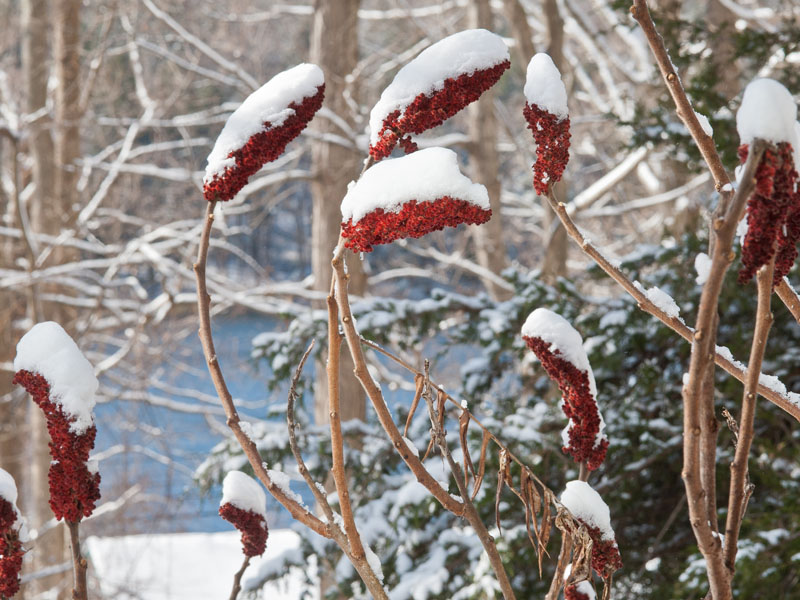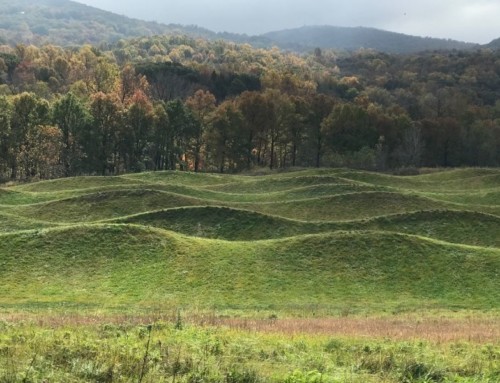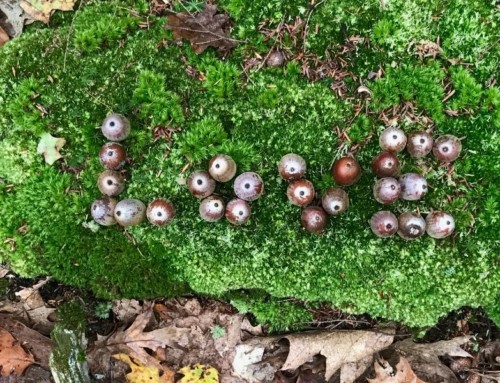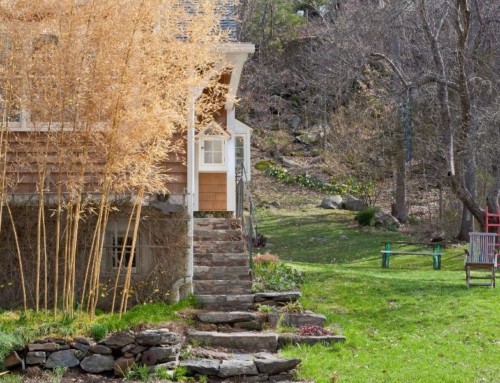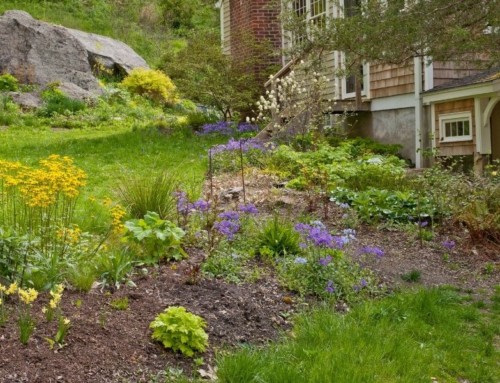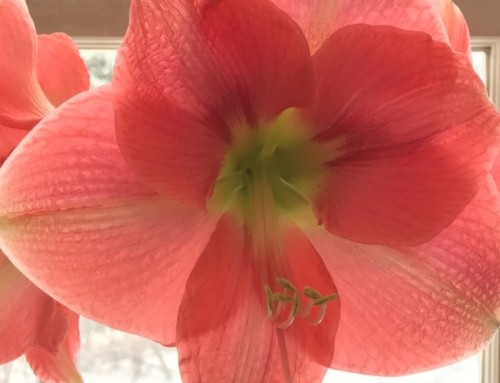Nothing is simple.
So here I am trying to create healthy habitat for wildlife in my yard – but some of that wildlife is making life difficult.
I love watching songbirds gobble down bugs and berries on the staghorn sumacs planted outside my front window and listening to owls whoo-ing nearby at night.
Seeing a fox amble across the back slope, trip over a vine, fall back on its haunches as a pair of mourning doves suddenly flew up in its face, then lick its paws clean and settle in for a nap in a sunny weed patch, recently made my day.
Where are the foxes and owls when I need them?
My garden beds and meadow planting look like swiss cheese.
While my back was turned, meadow voles (aka field mice) chomped and tunneled everywhere.
Voles severed the crowns of clump-forming native grasses, ate through shallow aster, moss phlox and Physostegia roots, undermined summer-planted Juncus plugs and displaced laboriously placed rocks.
This presents a dilemma. Sustainable land care practices and pest management are at odds.
How do I establish self-sustaining wildlife-friendly plant communities when the wildlife keeps eating my plants?
On the one hand …
I want to keep the ground covered with plants to
- Stem erosion
- Reduce maintenance
- Leave little space for weeds
- Provide cover for insects, birds and other wildlife
- Emulate structures, processes and look of natural plant communities
- Give me something interesting to look at year-round
A surprising number of plants have a presence in winter. I usually only cut back what looks bad, a little at a time, to stay on the good side of the line between naturalistic garden and depressing mess.
Small songbirds feast on small seeds of attractive stiff-stemmed native flowering plants (Rudbeckia triloba, Agastache foeniculum, Monarda didyma), and dried grasses in my garden, all winter long. If heavy snow or crashing deer knock plants askew, I snip the stems and stuff them into a big pot or strew them for ground-feeding juncos and mourning doves.
And, on that same hand …
I want to leave the leaves and plant debris that
- Shelter overwintering insects, insect eggs and larvae (food for birds, next spring’s bees, butterflies, moths, spiders and other beneficial insects)
- Smother weeds
- Keep the nutrient cycle rolling
- Support good soil biology
- Retain moisture
- Insulate the soil from freeze-thaw cycles, protecting roots
BUT – on the other hand …
- Leaf-covered garden beds with layers and layers of plants are vole nirvana. Especially if snow blankets the ground before it freezes solid.
- With plenty of food, good cover to conceal them from predators, comfy insulation and loose soil to burrow through, voles run amok.
- In winter, voles switch their diet from living plants to grains, seeds, bark, roots, persistent fruits and berries.
It can get ugly. One spring when I visited Monticello, gardeners said voles had eaten 1000 fall-planted tulips.
- Voles are fecund and voracious herbivores.
- They do not cache food.
- Or hibernate.
- Voles need to eat their body weight in food every day. All winter long. Including in my garden.
The Ecological Role of Voles
Trying to set aside my frustration, I searched for a more holistic perspective. Turns out voles (and mice) have significant positive impacts on their ecosystems.
You could even look at them as miraculous agents of transformation. They convert plants (by eating them) into hawks, owls, snakes and other predators (by being eaten).
A Pennsylvania State University Virtual Nature Trail report was especially enlightening:
- Their high rate of ingestion of vegetable materials stimulates decomposition and nutrient release.
- Their nutrient rich fecal pellets are widely dispersed through their habitats to the great benefit of new and growing vegetation.
- These voles also accelerate the dispersal of vital mycorrhizal fungi, and, thus, influence the survival and growth rates of many important species of trees.
- Meadow voles are most abundant in the open field and shrub ecosystems of early successional stages of disturbed ecosystems. Their presence and activities greatly influence the rate and direction of subsequent successional stages.
- Many predators consume meadow voles (hawks, owls, herons, crows, blue jays, skunks, weasels, cats, raccoons, shrews, a variety of snakes, snapping turtles, bullfrogs, even largemouth bass).
I can appreciate the role voles play in nature, but wish they wouldn’t play in my gardens. I paid a lot of money and worked really hard to establish the vegetable material they’re ingesting.
Trying to Limit Vole Damage
January’s crazy warm weather has made the living far too easy for voles, but it’s giving me a chance to catch up.
Time to toss the welcome mat. This year’s rodent population explosion calls for bare earth, with no place to hide, before the ground freezes. Here’s what I did:
- Cut back everything that sprawled or made raking difficult, leaving upright clumps with plenty of space between.
- Cut grasses where they touched the ground. I love those tawny tresses in winter, but they had been eaten or nested in. Only a few central portions of little bluestem remain to remind me that this wasteland is a garden.
- Regretfully sheared carpets of fine-textured moss phlox (Phlox subulata) as short possible. Still lush and green, they were riddled with snaking vole runs.
- Raked vigorously to remove leaves, plant debris and more than a few no-longer-attached plants. I pulled an astonishing volume of grassy vole nests from under clumps of spiky sheltering yuccas.
- Liberally sprinkled Plantskydd granular Vole-Rabbit-Deer repellant, with an extra shake in tunnel entrances. This dried blood product is OMRI listed, certified by the independent Organic Materials Review Institute for organic use. No new holes in the following weeks, it must be working.
- Pressed down the soil gently around undermined plants, less gently over tunnels.
The most vole holes – under the birdfeeder, around grasses and at the top of dry-laid stone walls.
The fewest holes – along the gravel and sharp-edged stone dust path
I’m wishing all the predators that cross my yard – owls, hawks, foxes, bears, bobcats – a very happy new year’s hunting.
Trying to Limit MY Damage
I’m always mindful of the first commandment of organic gardening – First do no harm – but sometimes desperation means coming up with creative ways to do the least amount of damage.
Getting rid of plant debris and leaves is not an environmentally sound practice. I wasn’t about to bag up butterflies in leaves and send them to the dump, just carefully relocate the biomass and its living cargo elsewhere in my yard.
- I scattered cut-back grasses, asters and other desirable native plants with seeds in wilder parts of the property. Birds can still eat the seeds and if I’m lucky, maybe some will germinate in new areas.
- Woody stems and plants with seeds I didn’t want to spread around went on the brush pile, a well-used backyard wildlife shelter.
- Many small native bees lay eggs in hollow or pithy stems. I left some 12-15″ stubs of Rudbeckia subtomentosa ‘Henry Eilers’ and other plants tough enough to stick around for next season’s bees and piled up some in bundles off to the side.
- I deposited leaves in long windrows rather than a single pile, hoping that insects won’t be buried too deeply to emerge in spring.
Now, let the cold weather begin!
My rodent problems could be worse. This fall a friend’s entire shrub dogwood thicket and several specimen shadblow trees disappeared overnight – beavers had moved in.
